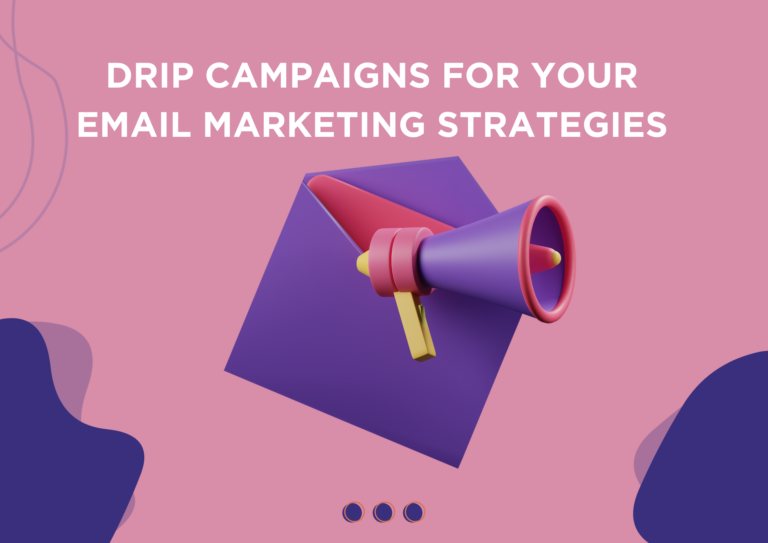How to Create Drip Campaigns for Your Email Marketing Strategies
The most favored marketing tool among all is email marketing. As far as connecting with customers goes, this is the best tool that businesses have.
Drip campaigns are one of the most effective email marketing strategies for nurturing leads, increasing engagement, and, eventually, conversions.
Learning how to design drip campaigns is essential if you want to improve your email marketing game.
We will cover all you need to know to become an expert at drip campaigns and enhance your email marketing strategy in this guide.
What are Drip Campaigns?
There are other names for drip campaigns, such as lifecycle emails or automatic email campaigns. They consist of an automated sequence of pre-written emails that are distributed to subscribers at specified times. Over time, these emails are intended to provide subscribers with suitable content that will guide them through the customer journey and build connections.

Why are Drip Campaigns Important?
Drip campaigns offer numerous advantages that make them an essential component of any email marketing strategy:
- Personalized Engagement: Drip campaigns allow you to deliver targeted content based on subscribers’ interests, behaviors, or interactions with previous emails.
- Lead Nurturing: By sending a series of strategically crafted emails, drip campaigns help nurture leads, gradually building trust and credibility with your audience.
- Automated Workflow: Once set up, drip campaigns run on autopilot, saving you time and effort while consistently engaging your subscribers.
- Increased Conversions: By delivering timely and relevant content, drip campaigns can lead to higher conversion rates and improved ROI.
Steps to Create Drip Campaigns
Now that we understand the importance of drip campaigns, let’s dive into the steps to create them effectively:
- Define Your Goals: Before you start crafting your drip campaign, clearly define your objectives. Whether it’s lead generation, product education, or driving sales, align your campaign with specific goals to measure its success effectively.
- Know Your Audience: Understand your target audience’s demographics, preferences, and pain points. Segment your subscribers based on these factors to deliver personalized content that resonates with each segment.
- Choose an Email Marketing Platform: Select a reliable email marketing platform that offers robust automation features for creating and managing drip campaigns. Popular options include Mailchimp, Constant Contact, and HubSpot.
- Map Out Your Campaign Flow: Create a visual map of your drip campaign flow, outlining the sequence of emails, triggers, and intervals between each email. Consider the subscriber’s journey from awareness to conversion and tailor your content accordingly.
- Craft Compelling Content: Write engaging and relevant content for each email in your drip campaign. Focus on providing value, solving problems, and addressing the needs of your subscribers at each stage of the customer journey.
- Set Trigger Points: Determine the triggers that will initiate each email in your drip campaign. Triggers can include actions such as subscribing to your list, downloading a resource, or abandoning a cart on your website.
- Optimize Timing and Frequency: Strike the right balance between sending too many emails and not enough. Test different send times and frequencies to find the optimal schedule that maximizes engagement without overwhelming your subscribers.
- Monitor and Analyze Performance: Track key metrics such as open rates, click-through rates, and conversion rates to evaluate the effectiveness of your drip campaigns. Use this data to refine your strategies and continuously improve results.
FAQs About Drip Campaigns
- What types of drip campaigns are most effective?
– Welcome Series: Introduce new subscribers to your brand and nurture them towards making a purchase.
– Onboarding Sequence: Guide new customers through product setup and usage to ensure a positive experience.
– Abandoned Cart Recovery: Remind customers about items left in their shopping cart and encourage them to complete the purchase.
– Reengagement Campaigns: Win back inactive subscribers by reigniting their interest with targeted offers or content.
- How long should a drip campaign be?
– The length of a drip campaign depends on your specific goals and the complexity of your customer journey. However, most drip campaigns typically consist of 3-5 emails spaced over a few days to several weeks.
- How do I avoid my drip campaign being marked as spam?
– To prevent your emails from ending up in the spam folder, ensure that your subscribers have opted in to receive emails from you. Additionally, use clear and relevant subject lines, avoid spammy language, and provide a visible unsubscribe option.
- Can I personalize drip campaigns for different segments of my audience?
– Absolutely! Personalization is key to the success of drip campaigns. Segment your audience based on factors such as demographics, purchase history, or engagement levels, and tailor your content to meet the specific needs and interests of each segment.
- What are some best practices for drip campaign design?
– Keep your emails visually appealing with a clean layout, compelling images, and mobile responsiveness.
– Use concise and persuasive copy that communicates your message clearly and prompts action.
– Include a clear call-to-action (CTA) in each email, guiding subscribers towards the next step in the customer journey.
In conclusion, mastering drip campaigns is essential for maximizing the impact of your email marketing efforts. By following the steps outlined in this guide and leveraging the power of automation and personalization, you can create highly effective drip campaigns that engage, nurture, and convert your audience. Remember to continuously monitor and optimize your campaigns based on performance data to achieve long-term success in your email marketing strategy.
